Foot, Ankle and Lower Leg Care, Assessment, Treatment and Rehabilitation
Learn more about our services, covering podiatry solutions for heel pain, sporting injuries, nail issues, and more
Paediatric Podiatry Services, ESWT, Referrals, Orthotics, Sports Podiatry, Biomechanical Assessments, Footwear Assessment, Foot Mobilisation Therapy, Diabetes Assessment, Nail and Skin Treatments, Nail Surgery, Dry Needling and more.
Do you want to learn more about our services? Are you ready to book your appointment
with us? Get in touch
with the team
today and let's get started.
Referrals
Our Podiatrists are able to refer for x-ray, ultrasound, and MRI scans if required, to aide and assist in the accurate diagnosis and subsequent implementation of an appropriate treatment plan.
If required, they will also refer to other allied health professionals e.g. physiotherapy, chiropractor if a multi-disciplinary treatment regime is required, or specialists such as Podiatric Surgeons if more extensive treatment/assessment is necessary.
Do I need a referral to see a podiatrist?
Generally, a referral is not required to see our podiatrists.
However, a referral from your GP is required for:
- Enhanced Primary Care Plans
- Department of Veteran Affairs Claims
- TAC and Work Cover Claims


Children’s Podiatry
Children’s feet are unique and complex structures. Early detection and treatment of foot related problems will benefit the health, mobility and general wellbeing of children, throughout their childhood and way beyond.
Ever wondered if your child’s feet or the way they walk is ‘normal’? We assess children of all ages to check their development.
We will assess the movement of their joints and muscles throughout their feet and legs and observe their walking pattern in a child-friendly environment. Where required, we will provide advice on footwear, stretching or strengthening programs, and play positions or activities. In some cases, wedges or children’s orthotics may be fitted into their shoes.
Common reasons children come to Elite Podiatry Centre may include:
- Frequent tripping
- Pain or tired legs
- In-toeing
- Toe walking
- Flat feet
- Curly toes
- Warts
- Nail problems
- Heel pain -Sever’s disease
SHOCKWAVE THERAPY
Extracorporeal shock wave therapy (ESWT), also commonly known as Shockwave Therapy is a non-invasive, non-surgical treatment. It provides treatment to patients suffering from a variety of chronic conditions such as Plantar Fasciitis and Achilles Tendinopathy, both of which can be notoriously difficult to resolve. It is often effective even where previous conservative management has failed.
Shockwave Therapy uses high-pressured acoustic shockwaves that travel through the skin from a special handpiece with the aim of reducing pain and stimulating a healing response.
How does shock wave therapy work?
Essentially shockwave therapy kick-starts the body’s repair process and causes...
- Reduction of pain felt by nerve fibres
- Increase of blood circulation in surrounding soft tissue
- Beginning of healing process triggered by stem cells activation
What Does A Course Of Shockwave Therapy Involve?
A course of shockwave therapy usually consists of weekly treatments for 3-6 weeks. Generally, the more chronic or significant conditions in nature are likely to require the longer course of treatment.
ESWT may be used to treat many chronic musculoskeletal conditions including:
- Plantar heel pain – plantar fasciitis, heel spurs
- Achilles tendinopathy - pain and or degeneration of the Achilles tendon
- Shin splints - aches and pains in the shin area
- Stress fractures - small fractures in the bone structure caused by repeated load
- Chronic ankle injuries - unstable ankles leading to further injury, or stubborn ankle injuries which refuse to heal
- Muscle and tendon injuries - strains or partial tears
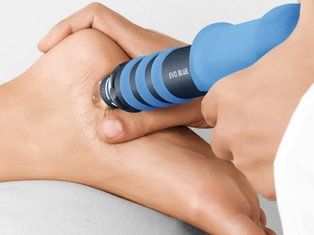

Orthotics
What are foot orthoses?
Foot orthoses, or orthotics as they are commonly referred to, are shoe inserts designed to support, align or improve the function of the foot and lower leg. There are many different types of orthoses, including custom, semi-custom and prefabricated (Off the Shelf) devices.
Your Podiatrist will make a specific recommendation for you once they have performed a thorough assessment, also taking into account your individual biomechanics, footwear, occupation and lifestyle.
Once we have established orthotics are required and are suitable for you, we take a 3D scan of your feet. Our lab produces 3D printed orthotics, which are lighter than the more traditional polypropylene devices with a similar flex and faster rebound rate.
Orthotics are rarely recommended as a lone treatment. They are usually issued in conjunction with one or more of the following: footwear advice, stretch and strengthening exercises, and physical therapies such as Foot Mobilisation Therapy or Dry Needling.
Not everyone with a foot or lower leg injury requires orthotics, but when they are indicated they can be a very effective treatment option to alter excessive stress and load to injured areas. Not only can this help current injuries, but it may also prevent future recurrence.
Sports Podiatry
At Elite Podiatry Centre, we understand and appreciate the need to get you back to your chosen sport as soon as possible.
Appropriate management of injuries in the first 48 hours can result in quicker healing and a speedier return to activity. If you sustain a foot, ankle or leg injury, it is important to begin rest, regular icing, compression and elevation of the leg.
Early assessment and accurate diagnosis by our Podiatrists is also important, giving us the opportunity to begin the most appropriate treatment plan for each person sooner rather than later. We will order x-rays, Ultrasounds and MRI when required, supporting your recovery with the latest medical technology.
At Elite Podiatry Centre we have emergency appointments available on Mondays to enable anyone who sustains an injury over the weekend to access the best care as soon as possible. Of course, an injury may occur at any time, and you can either contact our helpful receptionist or use our online bookings to arrange a consultation.
As well as the acute pain of an ankle twist or trauma to the joints in the foot, pain can develop more gradually over time. People often also experience this kind of pain or soreness as a result of sports or exercise, and we advise that you seek early advice for these problems before they worsen.
We can provide you with a plan to prevent the condition from progressing and to support your body as it recovers. This plan may involve advice on modification to your training and footwear, or information on specific exercise programs that will address any muscle imbalances or stability issues.
Other common treatments we often use when managing sports-related conditions are shockwave therapy, dry needling, strapping, rock taping, customised orthotics, offloading with CAM Walkers, and foot mobilisation therapy.
Our rehabilitation exercise program will be tailored specifically to address an individual’s needs and goals. With a thorough assessment and correct diagnosis, we can have you starting rehab while your injury heals, meaning that there is less deconditioning associated with your recovery.
Various types of stretching and strengthening exercises and proprioception/balance training is usually included in our programs, and is gradually progressed during your rehabilitation. We aim to include sport specific exercises to help prepare you for return to your particular sport in good condition. We will also advise on alternative training options to maintain your cardio fitness during the process.
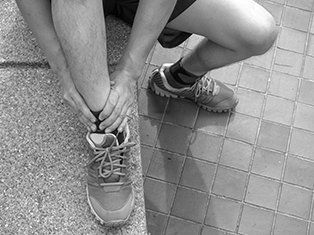
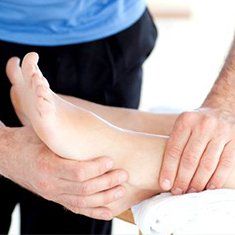
Biomechanical Assessments
A biomechanical assessment involves examining the way your lower limbs work and checking for abnormalities and possible causes of pain in the foot, ankle, knee and back.
Some of these investigations include:
- Muscle testing
- Range of motion assessment
- Static standing assessment
- Walking gait analysis
- Running assessment when indicated
Elite Podiatry Centre uses video treadmill analysis to assess your walking or running. Specific software allows slow-motion video feedback to be displayed, revealing the function of your feet, ankles, knees and hips and identifying any altered gait patterns.
Through our comprehensive assessments, we will be able to quickly and thoroughly determine the best treatment options available for you.
Footwear Assessment
Feet carry our bodies around every day. We walk, twist, turn, jump, hop, run, bend and stand. Shoes help protect and support our feet! When we run we increase the load on our feet to up to 3 times our body weight! Therefore, the right shoe with the correct fit can help to prevent injuries and overuse, while poor style or ill-fitting shoes can lead to foot and leg problems.
We will assess the shoes you wear for different activities and advise on your specific needs. This may be for casual, at home, work or recreation. We can recommend specific shoes for different sports, like football boots, netball, cricket, Hockey, tennis, lawn bowls, golf and hiking. Treadmill gait analysis of walking and running in your athletic shoes can be useful in determining the best footwear option for your foot type or injury.
Elite Podiatry Centre Podiatrists are experienced in advising people in our region on footwear options that will suit their work needs, whether that be work boots for farmers or tradies; and those who are on their feet all day like nurses, or those in retail.
People with certain medical conditions, like arthritis and diabetes, will have other shoe requirements that we will individualise advice for your needs. We aim to educate you so you are equipped to find comfortable, supportive and well-fitting shoes that will help keep you active and doing what you want to do in life.

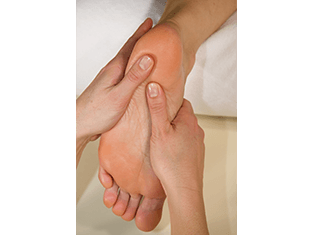
Foot Mobilisation Therapy
Your feet work best when everything is in the right place.
FMT involves hands-on treatment to apply gentle mobilisations and manipulations targeted at specific joints within the feet and legs to improve function and reduce pain.
Each of the foot and ankle joints are assessed to determine areas of joint restriction. By determining the patterns of movement, it is then possible to gently mobilise or manipulate the area to restore a normal range of unrestricted motion. If the joint restriction is long-standing, there can often be poor muscular control or ligament damage. These factors are taken into consideration as your Podiatrist begins to restore function.
In cases with long-standing problems, an initial block of appointments to restore joint mobility and function will be recommended before introducing strengthening exercises for long-term management. The use of manipulation and exercises to strengthen the foot can be a very effective combination.
Our Podiatrists are happy to look at combinations of treatments to provide our clients with the best possible outcomes. FMT may be used in combination with other treatments which may include footwear advice, stretching and strengthening exercises, orthotics, Dry needling and strapping.
Diabetes Assessment
People with Diabetes should have their feet assessed at least once a year to check their sensation and circulation. Diabetes can result in damage to nerve endings in the feet and/or reduce circulation. This can lead to further complications like ulcers in some cases. It is important to have your risk assessed each year so that we can detect any changes early. We will explain the results of each test and advise you on any precautions you need to take so we can look after your feet together.
We will use equipment to check the health of your nerves to ensure you can feel to protect your feet.
We will use doppler ultrasound to assess your circulation thoroughly. Our technology enables us to assess the amount of blood getting to your feet.
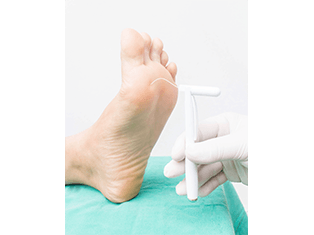

Nail and Skin Treatments
Elite Podiatry Centre helps people of all ages with skin or nail concerns. Sometimes toenails are too difficult to cut yourself; this may be because they are too thick or you are not able to reach or see the nails to trim them safely. Nails can also become ingrown and subsequently very painful. A Podiatrist has instruments to trim toenails and treat ingrowing nails. We can also help with fungal nail infections. People with Diabetes often require regular visits to the Podiatrist for routine treatment to ensure problems do not develop.
A callus is hard skin that develops on areas of the feet that are rubbing or under pressure. Corns are hard skin that forms a core due to pressure in a very localised area. Corns are generally more painful and can feel like stones. Corns and calluses may be caused by the way you walk, poorly fitting orthotics, tight shoes as well as some medical conditions.
A common area for hard skin formation is on the back of the heels, this is more prevalent during the warmer months when patients tend to wear open footwear resulting in painful cracking.
Treatment for corns and calluses is usually painless and involves removal of the hard skin using sterile instruments. Often this hard skin will build up again over time and therefore it is best to have your feet treated on a regular basis in order to remain comfortable and pain-free. Ideally, your Podiatrist will also consider the underlying cause of pressure and offer options to alleviate this. Sometimes this may be footwear recommendations, modified insoles or padding, protective toe devices, custom-made orthotics, and advice on how you can look after your feet.
Common skin and nail conditions we treat:
- Corns
- Calluses
- Cracked heels
- Warts/papillomas
- Tinea
- Thickened nails
- Curved or ingrown nails.
- Fungal nail infections
If you find it difficult to manage your toenails yourself, we can help.
Nail Surgery
Our Podiatrists commonly treat people with ingrown toenails and can usually provide instant relief during their initial visit. However, in some cases, ingrown toenails are a repetitive problem which may be caused by a hereditary curved nail shape or poor cutting technique.
At times we will recommend a minor surgical procedure to permanently resolve troublesome ingrown toenails. This is done in our clinic by our experienced Podiatrists under a local anaesthetic. This is a safe and effective surgical procedure, known as a partial nail avulsion, with minimal (if any) post-operative discomfort.
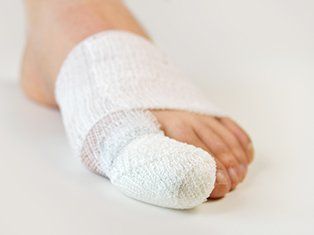
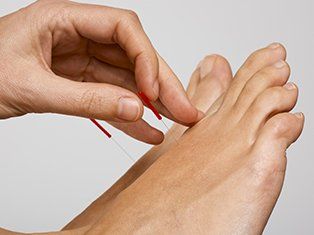
Dry Needling
Dry Needling is a treatment where fine needles are used to reduce pain through the stimulation of myofascial trigger points. These are firm, tender nodules found in the muscle due to tightness and overworking. These are found all over the body. These trigger points can be very painful when palpated and can refer pain to other regions of the body.
Trigger points can also lead to a muscle “switching off” or reducing the strength of its contraction. Dry Needling is similar to acupuncture, however, it follows different theories from the traditional Chinese medicine. Dry needling at trigger points has been shown to stimulate a response from the nerves which allows the muscle to relax and result in reduced pain.
The needles we use are incredibly fine and, for this reason, there is minimal to no pain felt when inserting the needles. There is often a “local twitch response” noted when needles are inserted into a trigger point with a rapid contraction of the muscle and sometimes a brief “cramping” type sensation is felt.
By reducing trigger points, individuals are often able to perform movements more efficiently and with reduced pain, facilitating better and more functional rehabilitation.
